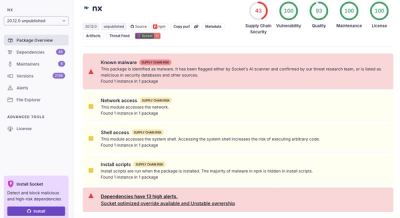
Security News
Nx npm Packages Compromised in Supply Chain Attack Weaponizing AI CLI Tools
Malicious Nx npm versions stole secrets and wallet info using AI CLI tools; Socket’s AI scanner detected the supply chain attack and flagged the malware.
@idiogi/focus-ui
Advanced tools
Cards are used to group similar concepts and tasks together to make the product for users easier to scan, read and get things done.
Cards should:
Headings should be:
Body content should be:
Buttons should be:
Section titles should be:
Links should be:
Use when you have a simple message to communicate to users that doesn't require any secondary steps.
<Card title="Website dashboard" sectioned>
<p>View a summary of your website performace.</p>
</Card>
Use for less important card actions, or actions users may do before reviewing the contents of the card. For example, users may want to add items to a card containing a long list.
<Card sectioned title="Variants" actions="[{ content: 'Add variant' }]">
<p>
Add variants if this product comes in multiple versions, like sizes or colors.
</p>
</Card>
Use footer actions for a card's most important actions, or actions users should do after reviewing the contents of the card. For example, users should review the contents of a page's seo settings before an important action like publishing the page.
<Card
title="Homepage SEO"
primaryFooterActions="[{ content: 'Add attribute' }]"
secondaryFooterActions="[{ content: 'Edit page' }]">
<CardSection title="Attributes">
<List>
<ListItem>My amazing page title</ListItem>
<ListItem>And a powerful description</ListItem>
</List>
</CardSection>
</Card>
Use when your card section has actions that apply only to that section.
<Card title="Customer">
<CardSection>
<p>John Smit</p>
</CardSection>
<CardSection title="Contact information" actions="[{ content: 'Edit' }]">
<p>john.smit@example.com</p>
</CardSection>
</Card>
Use to indicate when one of the sections in your card contains inactive or disabled content.
<Card title="Accounts">
<CardSection>
<List>
<ListItem>John Smit</ListItem>
<ListItem>Mister Anon</ListItem>
</List>
</CardSection>
<CardSection subdued title="Deactivated accounts">
<List>
<ListItem>John Smit</ListItem>
<ListItem>Mister Anon</ListItem>
</List>
</CardSection>
</Card>
The required title prop gives the card a level 2 heading (<h2>). This helps with readability and provides structure
to screen reader users.
If you use the subdued prop on a card or section, make sure that the card or section title conveys the reason
for using subdued. This ensures that users with low vision, including those who use screen readers, can identify
that the content is inactive or less important.
FAQs
Unknown package
The npm package @idiogi/focus-ui receives a total of 0 weekly downloads. As such, @idiogi/focus-ui popularity was classified as not popular.
We found that @idiogi/focus-ui demonstrated a not healthy version release cadence and project activity because the last version was released a year ago. It has 1 open source maintainer collaborating on the project.
Did you know?

Socket for GitHub automatically highlights issues in each pull request and monitors the health of all your open source dependencies. Discover the contents of your packages and block harmful activity before you install or update your dependencies.

Security News
Malicious Nx npm versions stole secrets and wallet info using AI CLI tools; Socket’s AI scanner detected the supply chain attack and flagged the malware.

Security News
CISA’s 2025 draft SBOM guidance adds new fields like hashes, licenses, and tool metadata to make software inventories more actionable.

Security News
A clarification on our recent research investigating 60 malicious Ruby gems.